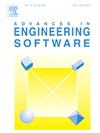A machine learning-based inverse analysis procedure for concrete softening law prediction using non-experimental datasets
IF 5.7
2区 工程技术
Q2 COMPUTER SCIENCE, INTERDISCIPLINARY APPLICATIONS
引用次数: 0
Abstract
This paper studies the mechanical behaviour of concrete as one of the most widely used quasi-brittle construction materials emphasizing on the importance of knowing its mechanical parameters and their evolution during the inelastic stage, i.e., the softening law. The softening curve, which describes the response of the material under damage or cracking, is critical for predicting the behaviour of concrete structures subjected to extreme loads. Experimental tests are commonly employed to obtain this information either directly or indirectly. Some of the indirect methods are based on inverse analysis and/or artificial intelligence techniques, both of which capable of predicting the mechanical parameters of concrete from the experimental results of one test, e.g., a notched beam subjected to vertical loads. However, an important drawback of these procedures is that they require a large dataset constructed from data gathered in multiple experiments in order to be developed. Consequently, most existing methods are tailored to specific types of experiments and even limited to certain specimen dimensions. Additionally, these procedures primarily focus on predicting mechanical parameters rather than determining the softening law. To address these limitations, this paper proposes a machine learning-based algorithm for the inverse analysis of an experimental test capable of predicting both the softening law and the mechanical parameters of concrete. By generating a non-experimental dataset through the Sequentially Linear Analysis (SLA) procedure, the proposed algorithm can be applied to other experimental setups suitable for analysis with SLA. The results of the application example demonstrate the effectiveness of the proposed approach.
基于机器学习的非实验数据集混凝土软化规律预测逆分析方法
混凝土作为一种应用最广泛的准脆性建筑材料,本文对其力学性能进行了研究,强调了解其非弹性阶段的力学参数及其演变,即软化规律的重要性。软化曲线描述了材料在损伤或开裂下的反应,对于预测混凝土结构在极端载荷下的行为至关重要。通常采用实验测试来直接或间接地获得这一信息。一些间接方法基于逆分析和/或人工智能技术,这两种方法都能够从一次测试的实验结果中预测混凝土的力学参数,例如,承受垂直载荷的缺口梁。然而,这些程序的一个重要缺点是,它们需要一个从多个实验中收集的数据构建的大型数据集才能进行开发。因此,大多数现有的方法都是针对特定类型的实验量身定制的,甚至仅限于某些样品尺寸。此外,这些程序主要侧重于预测力学参数,而不是确定软化规律。为了解决这些限制,本文提出了一种基于机器学习的算法,用于能够预测混凝土软化规律和力学参数的实验测试的逆分析。通过顺序线性分析(SLA)过程生成非实验数据集,该算法可以应用于其他适合使用SLA进行分析的实验设置。应用实例的结果表明了该方法的有效性。
本文章由计算机程序翻译,如有差异,请以英文原文为准。
求助全文
约1分钟内获得全文
求助全文
来源期刊

Advances in Engineering Software
工程技术-计算机:跨学科应用
CiteScore
7.70
自引率
4.20%
发文量
169
审稿时长
37 days
期刊介绍:
The objective of this journal is to communicate recent and projected advances in computer-based engineering techniques. The fields covered include mechanical, aerospace, civil and environmental engineering, with an emphasis on research and development leading to practical problem-solving.
The scope of the journal includes:
• Innovative computational strategies and numerical algorithms for large-scale engineering problems
• Analysis and simulation techniques and systems
• Model and mesh generation
• Control of the accuracy, stability and efficiency of computational process
• Exploitation of new computing environments (eg distributed hetergeneous and collaborative computing)
• Advanced visualization techniques, virtual environments and prototyping
• Applications of AI, knowledge-based systems, computational intelligence, including fuzzy logic, neural networks and evolutionary computations
• Application of object-oriented technology to engineering problems
• Intelligent human computer interfaces
• Design automation, multidisciplinary design and optimization
• CAD, CAE and integrated process and product development systems
• Quality and reliability.
 求助内容:
求助内容: 应助结果提醒方式:
应助结果提醒方式:


